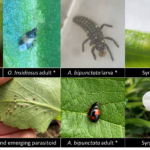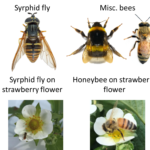The Two-spotted lady beetle, Adalia bipunctata, is a common insect predator, meaning it feeds on other, smaller bugs. Native to North America and Europe, the Two-spotted lady beetle is distinguished from other lady beetles by its oblong shape and two large black spots on either of its back, as well as its large white spots[Read More…]
Overwintering strawberries in high tunnels can jumpstart plant growth in the spring and protect developing flowers from frost damage and disease. However, this protected environment is also ideal for some pests, like spider mites and aphids, that can successfully overwinter and build their populations. We conducted an experiment on ‘Chandler’ strawberry where it was grown[Read More…]
Growing strawberries under high tunnels can extend the harvest season, provide protection against rain, frost, and disease, and improve overall yield and fruit marketability. Pest pressure, however, can be higher on protected culture strawberry compared to the open field. This is especially true for small, soft-bodied pests such as spider mites, aphids, and thrips. Even[Read More…]
After a long cold winter under protection, nothing signals spring like the first blooms on strawberry. ‘Tis the season in our high tunnels and thus time to provide a few reminders/updates on how to protect the development of these early fruits from insect pests. The first thing you want to do is examine the health[Read More…]
Insects provide an important pollination service in many crops including strawberry. Although strawberry flowers can self-pollinate without insects, it is well known that supplemental pollination by insects can result in better formed and larger fruit. Therefore, pollination services in strawberry affects both quantity (berry size) and quality (berry shape) of yield. By evaluating strawberry fruit[Read More…]
In the strawberry benchtop system in the greenhouses at Southwest Purdue Ag Center (SWPAC), we have been experiencing infestations in red berries of a small, clear larvae with a black head capsule. The larvae are often found in clusters on a single fruit and were difficult for us to identify. We encountered them in early[Read More…]






